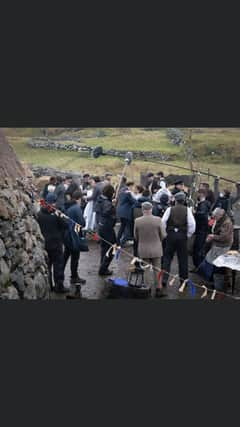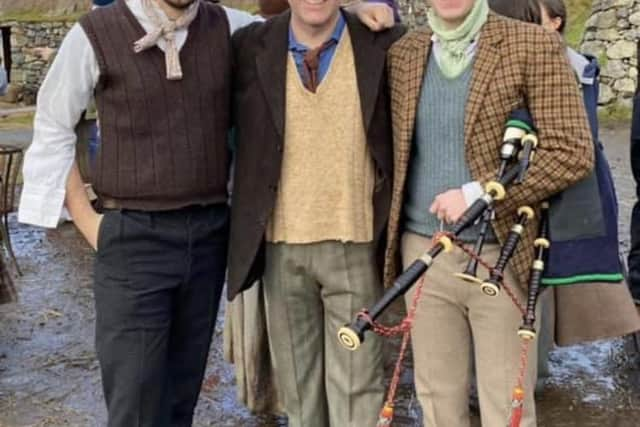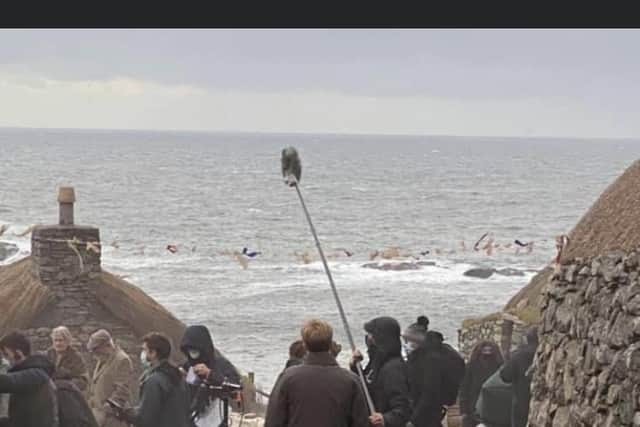Road dance that takes Garenin to big screen


And the author announced last week that post production for the film is now complete.
Published in 2002, the book is a tragic tale centred around an assault which takes place at a dance in Garenin held to send the young men of the village off to the Great War.
Advertisement
Hide AdAdvertisement
Hide AdIt is a powerful story and I was lucky enough to see the production take shape as an extra on the film last autumn.


John is, of course, best known as an STV presenter and is currently the chief anchor for the West Central Scotland edition of STV News at Six, as well as a presenter for current affairs programme Scotland Tonight.
He grew up in Hillington on the outskirts of Glasgow and attended Penilee Secondary School then Glasgow University.
His early steps in journalism were at the Sunday Post and BBC Scotland before he joined STV in 1994.
Advertisement
Hide AdAdvertisement
Hide AdJohn has strong links to the Western Isles. His mother Cathie was from Garenin and his father Alex from Kirivick, another village within Carloway. His aunt Katie Mary still lives in Garenin where the majority of the film is set and John visits whenever he is on the island.


His upbringing in Glasgow involved family visits to Lewis in the summer to stay with his granny in Carloway and John still holds fond memories from these visits.
“I spent almost all of my summer holidays at my granny’s house in Carloway, before returning to the mainland for the start of the new school term,” he said.
“I have so many fond memories of that time in my life. For a youngster it was true freedom and completely different from Hillington where I was brought up.”
Advertisement
Hide AdAdvertisement
Hide AdIt was during these visits that he became fascinated by the island tales which travel through generations.
One such tale involved a newborn baby being thrown into the ocean on the west coast of Lewis and it is incidents such as this which make the book such an emotional rollercoaster.
John is passionate about Garenin and was delighted that the film could be made in its true setting.
The cast and crew were in Carloway for six weeks and made use of the island scenery which will no doubt be a highlight of the film.
Advertisement
Hide AdAdvertisement
Hide AdI spoke to John this week to learn a bit more about the film’s background and what inspired him to base his first novel on a road dance in Garenin.
“I always had the ambition to write a novel and when I heard the story that formed the basis of The Road Dance, I knew that if I didn’t write that I would never write anything.
"I heard the story from a cousin in Garenin who said one of the ten commandments had been broken in the village.
"Knowing it as a God-fearing place, I was dismissive. ‘What about murder?’ I asked. And that’s when I first heard the story.”
Advertisement
Hide AdAdvertisement
Hide AdJohn’s second career started with The Road Dance, which was published by Luath Press in 2002. That was followed up two years later by Heartland and then The Last of the Line, both of which are also based on Lewis.
His debut novel was well received and quickly became a Scottish bestseller; the heart-breaking story combined with the stunning location making it a natural fit for the big screen.
John always hoped that one day the book would be made into a film but the journey hasn’t been straightforward; as he explained, like many before him, he found that finding a production company which would back its instincts with hard cash was tricky.
“The process of getting the story made into a film has been a long one,” he said. "I didn’t write it with any expectation of it being transferred to the screen. However, the Scottish actor David Hayman told me it was very cinematic.
Advertisement
Hide AdAdvertisement
Hide Ad"There was a long trail of production companies trying to make it happen, but the finance just couldn’t be raised.
“Then I was contacted out of nowhere by an American company, Sheridan Road Productions, and they’ve made it happen.
"I have never let myself get too carried away because there have been disappointments along the way, but there is a feeling of satisfaction that it has happened.”
This satisfaction stems specifically from John’s strong links to Garenin, a crofting township in Carloway on the west coast of the island.
Advertisement
Hide AdAdvertisement
Hide AdThe village has a population of about 40 and is most famous for its blackhouse village which can be found at the end of the Garenin road beside the bay. The Garenin blackhouses were lived in until 1974 and were the last inhabited blackhouses in the Western Isles.
The village was restored by Urras nan Geàrrannan (The Garenin Trust) in the nineties and now consists of four self-catering cottages, a museum (a blackhouse set in 1955), a café and a small gift shop.
It is, quite literally, a unique setting which has the twin advantages of being integral to the story and also visually compelling – almost like a movie set which has evolved for entirely different purposes, both in its past and present forms.
Despite all of that, there were times when it seemed that if the film was to be made at all, it might have been set elsewhere.
Advertisement
Hide AdAdvertisement
Hide AdJohn’s relatives stay less than half a mile from the blackhouse village and his passion for Garenin made him certain there was only one place the film should be made.
“I have been coming to Garenin all my life, but it’s only as an adult that I have fully appreciated what a unique place it is,” he said.
"In my novels, the setting is as important as the characters. I wanted the film to be set there and the producers were supportive of that.
"However, at various points when funding was being sought, there was talk of it being made in Ireland or Norway, even New Zealand. I am so pleased that it has been filmed where it is set.
Advertisement
Hide AdAdvertisement
Hide Ad“I think it would have lost something had it been filmed anywhere else.”
The film may have also lost something without its inspired casting.
The main character, Kirsty Macleod, is played by Hermione Corfield, who has already featured in Star Wars and Mission Impossible films.
Scottish TV actor Morven Christie plays her mother, Mairi, and Mark Gatiss of Sherlock and Dracula fame plays the island doctor.
Advertisement
Hide AdAdvertisement
Hide AdAlso on the cast is Tom Byrne who may be familiar to some after appearing in hit Netflix drama The Crown, a show which has been hugely popular and provides viewers with an insight into the lives of the Royal Family.
Byrne played Prince Andrew in the drama and is already starting to fulfil his potential, having made the transition to TV from theatre.
There were also a number of extras in the cast including myself, John and his two sons, all with zero experience of the film world. One of John’s sons, Ross, plays the bagpipes with the Scottish Power Pipe Band and plays the pipes during a scene – which definitely made him the most useful extra on the set!
The pipes he uses in the film were given to him by his grandad, who in turn received them from a World One veteran from Lewis.
Advertisement
Hide AdAdvertisement
Hide AdJohn himself plays ‘crofter number three’ in the film and explains how he ended up on screen.
“Just about the only thing I insisted upon was that my son, who is an accomplished piper, played the role of the piper onscreen,” he said.
"I had no particular wish to be in the film myself but the director kindly suggested that my other son and I should be among the extras.
"It was great fun, despite the weather being miserable on the day we filmed the crucial scene of the road dance.
Advertisement
Hide AdAdvertisement
Hide Ad"I may have ended up on the cutting room floor, but if I am still there, it’ll be a ‘blink and you’ll miss it’ moment.”
So a strong story, a great cast and a TV presenter turned writer turned film extra, it’s no wonder Sheridan Road Productions saw The Road Dance as a great opportunity.
Scotland has worked well for the Chicago based production company before with Tommy’s Honour winning best feature film at the 2016 British Academy Scotland Awards.
That historical drama centres around the complex relationship between Scottish golfing champions, Old Tom Morris and his son Young Tom Morris.
Advertisement
Hide AdAdvertisement
Hide AdStaying with the noble sport, the Sheridan team also filmed The Golf Explorers at St Andrews in 2019.
It is hoped The Road Dance will have a similar impact and John reports that post-production has progressed well.
“The film has been completed and, although I haven’t seen it yet, I have seen short trailers which are really good," he said.
"It has been entered for a few film festivals and that will dictate when it’s released. At this stage I don’t know whether it will be released in cinemas or through a streaming network.”
Advertisement
Hide AdAdvertisement
Hide AdA premiere at Carloway Community Centre or, more realistically, at An Lanntair in Stornoway would be something to look forward to and a massive achievement for a period-piece filmed as the Hebrides entered winter in the midst of a global pandemic.
John is, however, not one to rest on his laurels and is already on to his next project.
“My latest novel, called Home, is being released next month,” he added. “It is set in Lewis and is a family saga covering the different generations of one family though the turbulence of the 20th Century.
"The title refers to that very Hebridean concept of home. I was born and raised in Glasgow, but my parents always referred to Lewis as home.”
Advertisement
Hide AdAdvertisement
Hide AdA part of John will always see Garenin as home and his love for the village will soon be shared onscreen with a much wider audience.
As ‘crofter number three’ would have said, home is where the heart is.